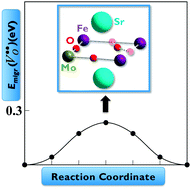Oxide ion transport in Sr2Fe1.5Mo0.5O6−δ, a mixed ion-electron conductor: new insights from first principles modeling
Abstract
We use ab initio density functional theory + U calculations to characterize the

* Corresponding authors
a Department of Chemical Sciences, University of Naples Federico II, Naples 80126, Italy
b Department of Chemical and Biological Engineering, Princeton University, Princeton, NJ 08544-5263, USA
c
Department of Mechanical and Aerospace Engineering, Program in Applied and Computational Mathematics, Princeton University, Princeton, NJ 08544-5263, USA
E-mail:
eac@princeton.edu
d Andlinger Center for Energy and the Environment, Princeton University, Princeton, NJ 08544-5263, USA
We use ab initio density functional theory + U calculations to characterize the

 Please wait while we load your content...
Something went wrong. Try again?
Please wait while we load your content...
Something went wrong. Try again?
A. B. Muñoz-García, M. Pavone, A. M. Ritzmann and E. A. Carter, Phys. Chem. Chem. Phys., 2013, 15, 6250 DOI: 10.1039/C3CP50995H
To request permission to reproduce material from this article, please go to the Copyright Clearance Center request page.
If you are an author contributing to an RSC publication, you do not need to request permission provided correct acknowledgement is given.
If you are the author of this article, you do not need to request permission to reproduce figures and diagrams provided correct acknowledgement is given. If you want to reproduce the whole article in a third-party publication (excluding your thesis/dissertation for which permission is not required) please go to the Copyright Clearance Center request page.
Read more about how to correctly acknowledge RSC content.
 Fetching data from CrossRef.
Fetching data from CrossRef.
This may take some time to load.
Loading related content
